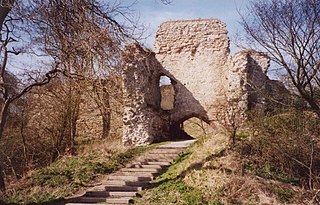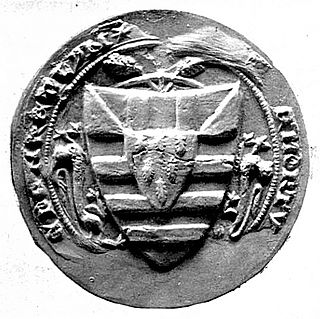
Edmund Mortimer, 5th Earl of March, 7th Earl of Ulster, was an English nobleman and a potential claimant to the throne of England. A great-great-grandson of King Edward III of England, he was heir presumptive to King Richard II of England when he was deposed in favour of Henry IV. Edmund Mortimer's claim to the throne was the basis of rebellions and plots against Henry IV and his son Henry V, and was later taken up by the House of York in the Wars of the Roses, though Mortimer himself was an important and loyal vassal of Henry V and Henry VI. Edmund was the last Earl of March of the Mortimer family.

Roger de Mortimer, 4th Earl of March, 6th Earl of Ulster was an English nobleman. He was considered the heir presumptive to King Richard II, his mother's first cousin.

Roger Mortimer, 3rd Baron Mortimer of Wigmore, 1st Earl of March, was an English nobleman and powerful Marcher Lord who gained many estates in the Welsh Marches and Ireland following his advantageous marriage to the wealthy heiress Joan de Geneville, 2nd Baroness Geneville. Her mother was of the Royal House of Lusignan.

Roger Mortimer, 1st Baron Mortimer of Wigmore, of Wigmore Castle in Herefordshire, was a marcher lord who was a loyal ally of King Henry III of England and at times an enemy, at times an ally, of Llywelyn ap Gruffudd, Prince of Wales.

Sir Roger de Mortimer, 2nd Earl of March, 4th Baron Mortimer of Wigmore, KG was an English nobleman and military commander during the Hundred Years' War.

Edmund Mortimer, 2nd Baron Mortimer of Wigmore was the second son and eventual heir of Roger Mortimer, 1st Baron Mortimer of Wigmore. His mother was Maud de Braose.

Wigmore Castle is a ruined castle about 1 km (0.62 mi) from the village of Wigmore in the northwest region of Herefordshire, England.
Gwladus Ddu,, full name Gwladus ferch Llywelyn was a Welsh noblewoman who was a daughter of Llywelyn the Great of Gwynedd and Joan Plantagenet, a daughter of John, King of England. She married two Marcher lords.

Several members of the Mortimer family were summoned to Parliament during the reign of Edward I, thereby making them hereditary barons in the Peerage of England. The most important family with this surname were the lords of Wigmore, a marcher lordship on the borders of Herefordshire and Shropshire with Wales, living at Wigmore Castle. The second Baron Mortimer of Wigmore was created Earl of March.
Ranulph I de Mortimer was a Marcher Lord from the Montgomery lands in the Welsh Marches. In England, he was Lord of Wigmore in Herefordshire. In Normandy, he was the Seigneur of St. Victor-en-Caux. Ranulph was the founder of the English House of Mortimer of Wigmore. He acquired Wigmore Castle after William Fitz Osbern's son Roger de Breteuil joined the Revolt of the Earls of 1075. His lands and holdings in Herefordshire and Shropshire were granted to him by William the Conqueror before 1086.
Hugh de Mortimer was a Norman English medieval lord.

Roger de Mortimer was a medieval marcher lord, residing at Wigmore Castle in the English county of Herefordshire.

Earl of Oxford and Earl Mortimer was a title in the Peerage of Great Britain. It was created in 1711 for the statesman Robert Harley, with remainder, failing heirs male of his body, to those of his grandfather, Sir Robert Harley. He was made Baron Harley, of Wigmore in the County of Hereford, at the same time, also in the Peerage of Great Britain and with similar remainder as for the earldom. Harley was the eldest son of Sir Edward Harley and the grandson of the aforementioned Sir Robert Harley.
Joan de Geneville, 2nd Baroness Geneville, Countess of March, Baroness Mortimer, also known as Jeanne de Joinville, was the daughter of Sir Piers de Geneville and Joan of Lusignan. She inherited the estates of her grandparents, Geoffrey de Geneville, 1st Baron Geneville, and Maud de Lacy, Baroness Geneville. She was one of the wealthiest heiresses in the Welsh Marches and County Meath, Ireland. She was the wife of Roger Mortimer, 1st Earl of March, the de facto ruler of England from 1327 to 1330. She succeeded as suo jure 2nd Baroness Geneville on 21 October 1314 upon the death of her grandfather, Geoffrey de Geneville.

Eva Marshal (1203–1246) was a Cambro-Norman noblewoman and the wife of the powerful Marcher lord William de Braose. She was the daughter of William Marshal, 1st Earl of Pembroke, and the granddaughter of Strongbow and Aoife of Leinster.

Katherine Mortimer, Countess of Warwick was the wife of Thomas de Beauchamp, 11th Earl of Warwick KG, an English peer, and military commander during the Hundred Years War. She was a daughter and co-heiress of Roger Mortimer, 1st Earl of March and Joan de Geneville, Baroness Geneville.
Maud de Braose, Baroness Mortimer of Wigmore was a noble heiress, and one of the most important, being a member of the powerful de Braose family which held many lordships and domains in the Welsh Marches. She was the wife of Roger Mortimer, 1st Baron Mortimer of Wigmore, a celebrated soldier and Marcher baron.
Isabella Mortimer, Lady of Clun and Oswestry was a noblewoman and a member of an important and powerful Welsh Marcher family. Although often overshadowed in modern historiography by her better-known parents, she is now known to have played an important part in her family's struggles against Llywelyn ap Gruffudd and to have helped to secure the frontline at Shropshire in the run-up to English conquest of Wales. She was the wife and widow of John III FitzAlan, baron of Clun and Oswestry and de jure earl of Arundel. After a lengthy widowhood, she married for a second time and largely disappeared from the records.

Roger Mortimer, 1st Baron Mortimer of Chirk was a 14th-century Marcher lord, notable for his opposition to Edward II of England during the Despenser War.
William Crassus I , aka Le Gros or Gras and Grace, was the son of Stephen II Le Gros born 1112 second son of his parents were Stephen I(Etienne)and wife daughter of Roger De Mortimer. William was from an Anglo-Norman baronial family long established in central Normandy. The house of Blois He inherited Sodbury from his uncle, [[William le Gros, 1st Earl of Albemarle aka Guillaume le Gros, Count of Aumale; married Cecily de Rumily of Skipton,[a] daughter of William fitz Duncan.]], primo-genitus. Brother of Stephen II - William was granted a licence to hold fairs and markets in Chipping Sodbury in 1217.








